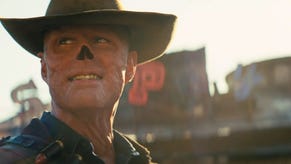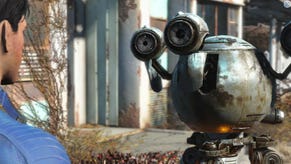Wot I Think: Fallout 4
The beautiful end of the world
Fallout 4 [official site] is an open-world roleplaying game from Bethesda Game Studios, creators of Skyrim, and is set in the Boston area of America, 200 years after nuclear war all but wiped out a technologically-advanced civilization. Your character emerges into this blasted world after centuries in cryosleep, then must choose their own objectives and allegiances while battling mutants, monsters, machines and militia. It's out tomorrow.I spent last week with it, and here's what I made of it. This piece does not contain any plot spoilers.
52 hours. A level 29 character. 27/50 achievements. Two different endings seen. Feel like I've barely scratched the surface. Size, of course, is something we can all but take for granted from the follow-up to Skyrim and Fallout 3 – the lingering question is whether a new layer of quality could be applied to all that wasteland quantity.
Well, good news. Either technology finally caught up to Bethesda's aspirations, or they took so many arrows to the knee from the resoundingly popular but much-lampooned Skyrim that they finally did something about the presentation issues we've been whining about. The refreshingly characterful Fallout 4 fixes problems which have dogged their games for years - although it then throws in brand new ones to compensate, and it maintains the traditional smattering of bizarro bugs and underwhelming combat.
Perhaps Fallout 4's greatest failing is one which will please hundreds of thousands of people - the apple hasn't fallen far from the tree. 'Oblivion with guns' comments about Fallout 3 notwithstanding, this is the Bethesda game which is most like its preceding Bethesda game. When I sit back and think about what I've been doing, I realise that, underneath the newly crisp and colourful skin, it's exactly what I was doing in Skyrim, Fallout 3 and Oblivion before it.
From spending far too long crafting minor weapon upgrades to painstakingly dressing up an AI companion who keeps getting stuck on scenery, from clumsily decorating my homestead to pickpocketing everyone in sight, and most of all from constantly interrupting my current goals with a new questline to endlessly fighting men and monsters. Structurally, no matter how much it might contain and how flashy it looks, Fallout 4 almost always boils down to Go Here / Kill Lots Of Things / Upgrade / Do It Again.
This is business as usual despite numerous tweaks here, fleshings-out there and this twin series’ most impressive presentation to date. Its surprises really come only from art, and almost never from possible actions you can take. On paper, Fallout 4 isn't doing a whole lot new, and there's definitely an argument to be made that the Fallouts are simply the tock to The Elder Scrolls' tick (to use the terminology applied to iPhone S releases). Despite their many flaws, Oblivion and Skyrim were still experimenting with the possibilities created in Morrowind, but like Fallout 3 before it Fallout 4 only really pushes the ideas forward in terms of themes and guns.
This would be damning, were it not for the fact that Fallout 4 does much of what it does so, so much better than Fallout 3 particularly, but also than Skyrim.
Tradition dictates that I should spend a few paragraphs moaning about how turgid the voice-acting is, how pudding-like the character faces are, how lacklustre the storytelling. And... I'm not going to. I don't have to. Those things, those ancient Bethesda bugbears, have improved immeasurably. Not completely, but speaking as someone who repeatedly tried to kill Brother Joffrey in Oblivion so I didn’t have to hear his wretched voice again, tried to mute all Fallout 3’s voices to spare myself from lifeless shopkeepers’ dull ‘a traveller, eh?’ utterances and made arrow/knee Skyrim references only as a demonstration of contempt, I simply haven’t seen red in that way during Fallout 4.
We're not looking at best-in-class character modelling by a long shot, and unfortunately most of the peripheral NPCs still move like clockwork-powered automatons, but the leap is dramatic enough that I'm happy to wave away the remaining shortcomings as a consequence of how much the game has to show at any one time.
Even the many, many minor bugs – people raining from the sky, farm animals mysteriously stranded on rooftops, NPCs with chairs sticking through their midriffs, enemies I could pickpocket a supposedly rare and precious resource from infinitely, disappearing companions, allies who’d futilely attempt to sprint through solid surfaces, and so many entities getting caught on scenery so frequently that you’d swear the nuclear bombs had mutated the entire world into Velcro – didn’t bother me. I guess partially I’m now so familiar with those sorts of glitches in Bethesda games that I’m almost fond of them, but partially they’re simply far less depressing when the overall presentation is so powerfully improved.
The most striking improvement is to plot-central characters and companions. These benefit from extra-detailed and more carefully-animated faces; this paired with bolder character design, more characterful and convincing writing and what seems to be a whole new broom when it comes to voice direction (far more of a problem than the actors themselves were) makes Fallout 4's cast and dialogue revelatory by its developer's recent standards.
Though the optional NPC companions might not quite be up to BioWare standards (and there's certainly a whole lot less you can do with/to them), they are at least within touching distance now. There are people I wanted to have with me because I enjoyed their company, not just because they ticked the requisite combat boxes.
Even quest-givers and other major NPCs have presence now. Rarely did I feel some hired voice was reading a script aloud for the first time, or that I was listening to the first respondent to a casting call for 'Evil Gangster Boss Guy'. (The exception being generic bandit-type cannon fodder enemies, but this relates to wider problem with these I'll come back to later).
A fat injection of colour into the wasteland makes an enormous difference too. In its defence, Fallout 3 came at a time when post-apocalyptic settings in mainstream pop culture were still relatively rare, and irradiated deserts still seemed exciting compared to traditional RPGs' forests and caves, but even so, it was bleached of far more life than it needed to be to sell the fantasy. Here, it’s as though a brown fog has been lifted.
Sadly Fallout 4 still makes the errant assumption that not a single tree would have survived or sprouted even one leaf after two centuries after the bombs fell, so a foundational brown’n’grey remains – but then again it is the series’ signature look.
Fortunately this game does reason that radiation would not, in fact, have removed both all existing paint and the materials with which to create new paint from existence, and so almost every single scene flashes with smatterings of vibrancy. There’s a slight cheat going on in that, even though the game is set at least 200 years after the bombs fell, its New England is designed to look as if the apocalypse was relatively recent. This means more colour, and more dark detail too – skeletal bodies found, BioShock-style, near logs and props which tell the story of their final hours, and near-intact shops and buildings which feel abandoned, Marie Celeste-style, rather than dilapidated and looted into ruin.
Similarly, a peculiar number of terminals and defence systems have retained power even after all these years and all that destruction. But while there might be logical fallacies underpinning this (though that’s an absurd claim to make anyway, given Fallout is inherently maximalist, anything-goes sci-fi rather than true grit realism), I’m entirely happy with it – it’s more life, colour and personality to the world, saving it from the hollowness of Fallout 3’s brown, dead sprawl.
The same new vibrancy is true of outfits; although armour remains faded and ramshackle, there’s a huge amount of non-combat apparel on show, from sparkly sequin dresses to Thin White Duke suits. These can make NPCs more distinctive, or inject a little bit of Saint’s Row dress-up merriment into your own character. (Clearly, a dress or suit has no defensive capabilities so you’ll don armour for quests and fights, but they do tend to have Charisma or Perception bonuses, thus are highly useful when shopping or stealing in towns).
Looking through my hundreds of screenshots, the vast majority are simply me posing my hero in a new outfit. It’s here that Fallout 4 is at its most playful, and most successful at offering self-expression rather than mere utility. It’s almost as though Bethesda are trying to get a march on modders – or perhaps openly inviting them to make silly stuff. Fallout suits that far more than The Elder Scrolls ever could, after all.
Which brings me to a complaint of sorts, and that relates to tone. I can’t go into plot details, but it gets very dark very quickly, and then seems to create a pulsing sense of urgency. Your character, a survivor from just before the bombs dropped, is leaving Vault 111 in order to rescue someone very important to them, and very vulnerable. There’s a sense that every moment matters – until it doesn’t. Fallout 4’s very nature is to be a teeming mass of distractions, and pinballing from the gruesome to the absurd, and from micro-managed shopping to doing other people’s routine dirty work. It simply can’t maintain that urgency, that sense of crisis and tar-black seriousness.
It’s analogous to how Batman’s mission to save Gotham from this psychopath or the other in the Arkham games is constantly undermined by rooting around for Riddler trophies, but at least Batman didn’t stop to try on a new hat or find seven broken toasters so he could weld new bits onto his armour.
Of course, historically the main questline in Bethesda games is but a sideshow to your fundamental freeform existence in the world. The big stories are good for dramatic back-of-the-box blurb and self-important trailers, but really they’re just a structure to guide players across the world and provide guidance for players who freak out it there isn’t a quest arrow as soon as the tutorial ends. While you can of course go entirely off-piste almost immediately and for as long as you like, here the main plot both feels more time-sensitive (though it isn’t in reality) and a little more intrinsic to the world. Where these games usually offer discreet sub-campaigns for the factions you can optionally join, here all those feed into the main story, as do several side-quests, and there are even large, spectacular, oft-revisited areas that you’ll only get to see if you head deep into the central quests. All this is great in terms of providing a new coherency, but it does feel a little like Fallout 4 is trying to have its cake and eat it – be an open world game and a Big Story game.
I actually think it broadly gets away with this, bar some discomfort in the first hour or two that I wasn’t getting on with The Very Important Thing and that my character barely ever mentioned it despite being in tears not long ago. (And, in fairness, Fallout 1 did something similar, though there the comparisons pretty much end). The plot is pure pulp and drizzled with perhaps inadvertent silliness, but it’s BIG, has this driving sense of escalation to it, and builds to its conclusions carefully rather than abruptly, with plenty of opportunity to make your mind up about who you’re going to support – or even double-cross.
It’s not a case of having a do-or-don’t finale dropped on you in the final mile, but rather of making ongoing choices with their own setpiece quests throughout. Put it this way: you’re not to be quickloading a save from two minutes before the end, Deus Ex-style, so you can try out every conclusion for size. To see the endings I haven’t yet brought about, I’ll need to go several hours backwards.
A conclusion, then, feels earned, and you get to see some immense stuff both within quests and across the world as a whole in the process. There are several facepalm moments as the denouements approach, and we’re going to see some exasperated articles and videos about them, but for my money it’s nothing like as clanging as Fallout 3’s resolution. Best of all, several key storylines resume after the ‘ending’ sequence plays. To what extent I don’t yet know as it became time to write, but I’ll be doing some follow-up pieces. Right now I feel there is still tons to mine from the game; if nothing else, despite hitting level 28 after 50 hours, I can see skill unlocks which require me to be almost level 50, and most of the in-game map remains unexplored. If I want it to, this is going to keep me busy for at least the rest of the year.
On page two: combat, disappointments, crafting and a conclusion.
That said, now we’re getting into what I personally felt most disappointed by, which is that Fallout 4 ultimately always defaults to being a shooting game. And not a great one at that. The conclusions I’ve seen both mandated climactic mass slaughter with almost no options to talk your way out of things, and thus no way to argue that you are not a murderous arsehole no matter how good or bad a person you’d tried to be up until that point, and I’m willing to bet that most of the other endings play out similarly.
I’d made Charisma my main discipline in order that I’d have the best chance of chatting my way to peace, but persuasion and intimidation options are largely restricted to wringing a little more information or booty out of quest-givers and, less frequently, -enders. However, as I say – I feel as though I’ve barely scratched the surface of the game’s contents even though I’ve seen all its features many times over. There are, for instance, at least two plot-critical factions whose questlines I barely began – perhaps they might have led to more civil outcomes. But given the vast majority of minor quests have the same structural reliance on routine shooty-bang, I doubt it.
That I am essentially forced to slay almost everyone in quests is particularly disappointing given that one bravura moment during the main plot goes out of its way to show why an early-game villain turned bad, and make you feel sympathy for him - and in turn everyone corrupted by this blighted place - but it's quite happy for every other raider or mutant or brutish soldier to be gunned down without hesitation. It's the GTA IV problem, perhaps - Niko's guilt co-existing with Niko's ongoing psychopathy.
In any case, I’d be moaning about that stuff a whole lot less if the shooting wasn’t, well, bobbins. I said earlier that Fallout 4’s presentation finally escapes the woodenness of past Bethesda games, but in combat the geriatric Gamebryo roots reveal themselves. Despite clear attempts to be a better shooter (with Destiny cited as an inspiration), masses of enemies moving around quickly sees them revert to that oddly weightless, puppety scuttle so familiar from Oblivion and onwards. They don’t feel quite… there, even though the game's working overtime to appear as though it's a full-blown shooter. The weapons are a big improvement over Fallout 3, feeling more tangible in addition to looking more interesting and offering more variety, but combat still comes down to gradually carving away health bars rather than twitchy headshot precision.
I know this is nebulous, and refers to everything from animation to physics to sound effects, but the shooting simply doesn’t feel quite right – it’s unsatisfying and repetitive, and the enemies more obstacle than threat. It’s certainly not disastrous, but is stuck in even more of a halfway house between RPG and shooter than Fallout 3 was. I imagine the series’ future is likely to be more like Borderlands (speaking purely in terms of combat), but the gunplay falls a long way short of that for now. Insult to injury is enemies' propensity for grenade spam, which does massive damage and I rarely felt I was given enough time to get out of the way. I wonder if it thinks it can be COD; in any case, it certainly doesn't manage to be.
VATS, the divisive, recharging slo-mo targeting system from Fallout 3 makes a more convincing but less critical return, aided in large part by the improved presentation. Less ponderous and more convincingly-animated, it doesn’t look and feel faintly ridiculous anymore, and if anything I found the combat far more satisfying with it than without it. Sadly, although I could have increased its usefulness by building my character differently, it isn’t really designed to cope with the large numbers of foes the game throws at you during the later stretches. But I like it rather than hate it, which is a big turnaround from how I felt about Fallout 3. I’d have fairly happily played in perma-VATS if I could, although I dread to think how long that would have taken me.
As far as character builds go, I’m not an enormous fan of the new levelling system. To recap, you no longer improve skills by practicing them, but rather pick a new Perk every time you level up (and levelling up happens from a combination of combat, conversation, crafting and criminality). The Perks are presented as what is, to all intents and purposes, a laughably oversized JPEG that you must manually sweep your cursor across in order to painstakingly read exactly what icon does what.
It’s all very statty too, such as you need to be level 41 to max out lockpicking or have maxed out Charisma to unlock the Intimidation skill. I’d just about say it’s a better system than grinding skills by building 300 bracers or crouch-walking for miles in Skyrim and its ancestors, but it does feel a whole lot more artificial – building around arbitrary impasses more than building towards something. I miss seeking out high-level skill trainers in the world too; it’s underwhelming to simply click a button and suddenly be a pro pickpocket or energy weapon crafter.
The bizarrely perfunctory presentation of the Perks interface also relates to a broader wooliness of the UI. Everything you need is there, but Fallout 4 does a bad job of telling you about it. I was, for instance, level 10 before I realised the Perks screen scrolled downwards, and had been wondering how and where to improve my lock picking. Similarly, I’d been all ready to decry the shopping UI as gamepad-centric, endlessly scrolling idiocy until an errant click revealed small, not always-visible categorisation arrows. At no point did the game tell me that VATS existed, let alone how to use it, although I knew full-well already. There’s this new town-crafting system which requires assigning recruited NPCs to farms and machines you’ve built, but after many hours I only found out how to do it by accident.
Ultimately none of this matters as you’re going to figure it all out sooner or later, but it contributes to a slight sense of feature creep: all this stuff piled up in a big jumble. Broadly though, the UI on PC is not quite as consolified as Fallout 3 or Skyrim, but it’s a bit confused and is certainly not making the best use of screenspace.
The aforementioned town-crafting system bears its own mention. It’s almost entirely optional, bar a couple of core quests and a larger role in one faction’s non-compulsory missions, but it’s a powerful toy for those who want it. The idea is that all the random junk you collect from the world can be distilled into fundamental components – plastic, copper, steel, microchips, adhesive and the like – from which buildings parts, furniture, automated defences and even electrical systems can then be constructed.
Primarily it’s keeping up with the Minecraft Joneses, and feels a little vogueish for it, but it’s also being The Sims – an opportunity to further populate Fallout 4’s world with around half a dozen extra towns of your own creation. While their inhabitants – who will slowly grow in number so long as you provide for them – behave robotically and serve little function, there is some living and breathing. Traders will be attracted, as will invading enemies, this latter leading to some neat little random NPC battles, reminiscent of when opposing factions unexpectedly collide in STALKER games.
In a way it’s the natural step up from the houses we’ve been able to buy and partially decorate in earlier Bethesda games, but now much more a freeform design toy than a reflection of in-game wealth. I’m particularly interested to see what people make with the electrical stuff, which involves switches and breakers and music-making devices and all sorts. I didn’t do much more than set up food and defence systems, partly because of time pressure and partly because it all felt so disassociated from the main game, but like the costumes it feels like somewhere that modding will be able to go absolutely wild, and give Fallout 4 an exceptionally long life.
A side-effect of this system is that I became acutely aware of familiar building and furniture pieces repeating across the world – that Bethesda had largely used the same elements they’ve provided to players when creating their own Boston.
52 hours in, would I go back for more? Yes, absolutely. I lived and breathed Fallout 4 for the vast majority of last week and the fact I was mostly having a damn good time meant I did it willingly. It’s glitchy, a little repetitive and over-familiar, and far too heavy on unconvincing combat, but the improved technology (or the budget) means it’s able to realise the dense, detailed, beautiful decay that Fallout 3 did not, and its dramatically better-presented and performed characters means it’s not shooting itself in the foot in the way Oblivion and Skyrim did. The personality gulf between Bethesda games and BioWare games feels a whole lot narrower now. I won’t for one second pretend that it’s what devotees of Fallout 1 and 2 want, but it does feel like the game Fallout 3 tried and, to my mind, failed to be.
Vibrant and characterful as well as immense, Fallout 4 is the giant leap forwards Bethesda’s RPGs sorely needed in terms of presentation, though the unrelenting focus on routine, lightweight combat sees it fall just short of triumph status.
A technical addendum - for me Fallout 4 mostly managed a steady 60fps at max detail (bar shadow quality, which I dropped from Ultra to High) and 1440p on a GTX 970 and a first-gen Core i7 overclocked to 4GHz. There was one particular indoor area which saw it drop to 35, but that was very much the exception rather than the rule. I also experienced no crashes. I'm afraid I'm not in a position to talk about multi-GPU support.
Fallout 4 is out tomorrow.
























